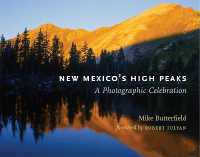- ホーム
- > 洋書
- > 英文書
- > History / World
Full Description
Southwestern archaeology has long been fascinated with the scale and frequency of movement in Pueblo history, from great migrations to short-term mobility. By collaborating with Pueblo communities, archaeologists are learning that movement was—and is—much more than the result of economic opportunity or a response to social conflict. Movement is one of the fundamental concepts of Pueblo thought and is essential in shaping the identities of contemporary Pueblos.
The Continuous Path challenges archaeologists to take Pueblo notions of movement seriously by privileging Pueblo concepts of being and becoming in the interpretation of anthropological data. In this volume, archaeologists, anthropologists, and Native community members weave multiple perspectives together to write histories of particular Pueblo peoples. Within these histories are stories of the movements of people, materials, and ideas, as well as the interconnectedness of all as the Pueblo people find, leave, and return to their middle places. What results is an emphasis on historical continuities and the understanding that the same concepts of movement that guided the actions of Pueblo people in the past continue to do so into the present and the future.
Movement is a never-ending and directed journey toward an ideal existence and a continuous path of becoming. This path began as the Pueblo people emerged from the underworld and sought their middle places, and it continues today at multiple levels, integrating the people, the village, and the individual.
Contents
Preface
Introduction: Engaging with Pueblo Movement
Robert W. Preucel and Samuel Duwe
Part I. On Becoming
1. Movement as an Acoma Way of Life
Damian Garcia and Kurt F. Anschuetz
2. Movement Encased in Tradition and Stone: Hemish Migration, Land Use, and Identity
Paul Tosa, Matthew J. Liebmann, T. J. Ferguson, and John R. Welch
3. Anshe K'yan'a and Zuni Traditions of Movement
Maren P. Hopkins, Octavius Seowtewa, Graydon Lennis Berlin, Jacob Campbell, Chip Colwell, and T. J. Ferguson
4. Tewa Origins and Middle Places
Samuel Duwe and Patrick J. Cruz
5. To and From Hopi: Negotiating Identity Through Migration, Coalescence, and Closure at the Homol'ovi Settlement Cluster
Samantha G. Fladd, Claire S. Barker, E. Charles Adams, Dwight C. Honyouti, and Saul L. Hedquist
Part II. Always Becoming
6. Seeking Strength and Protection: Tewa Mobility During the Pueblo Revolt Period
Joseph Aguilar and Robert W. Preucel
7. Apache, Tiwa, and Back Again: Ethnic Shifting in the American Southwest
Severin Fowles and B. Sunday Eiselt
8. Moving Ideas, Staying at Home: Change and Continuity in Mid-Eighteenth-Century Tewa Pottery
Bruce Bernstein, Erik Fender, and Russell Sanchez
9. Toward the Center: Movement and Becoming at the Pueblo of Pojoaque
Samuel Villarreal Catanach and Mark R. Agostini
10. Getting Accustomed to the Light
Joseph H. Suina
Commentary: Pueblo Perspectives on Movement and Becoming
Paul Tosa and Octavius Seowtewa
Contributors
Index








